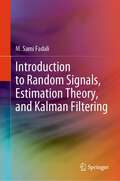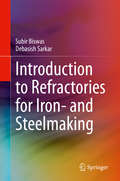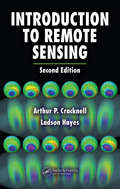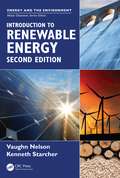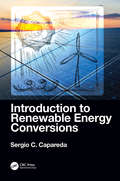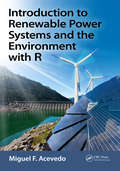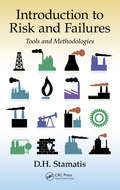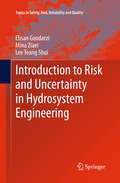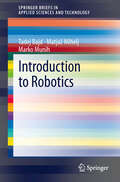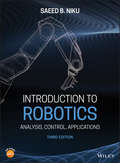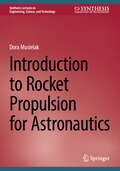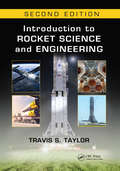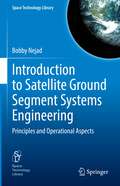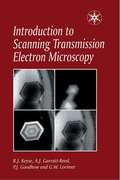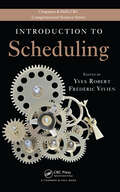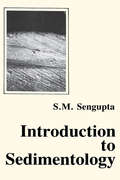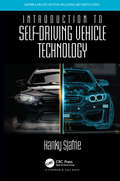- Table View
- List View
Introduction to Raman Spectroscopy and Its Applications
by Carlos Vargas HernándezThe book explores theoretical foundations of Raman spectroscopy, looking into key concepts such as parameters, perturbation theories, normal vibration modes, and the application of group theory to specific structures. It also examines modifications of the Raman technique, particularly in the Surface Enhanced Raman Scattering (SERS) modality. Practical aspects of both Raman and SERS spectroscopy are covered in detail. Additionally, the book presents the characteristic Raman spectra of various materials measured by the author, along with a basic analysis of their molecular structures. This comprehensive approach ensures that readers gain a thorough understanding of both the theoretical and practical elements of Raman spectroscopy. Developed from the author's notes, research, and over a decade of teaching the Raman spectroscopy course, this book underscores the vital importance of spectroscopies in both academia and industry. These techniques are invaluable in the analytical field, offering powerful tools for the study and diagnosis of materials due to their capabilities for both quantitative and qualitative applications. Optical spectroscopies, inherently non-invasive, have gained popularity due to advancements in monochromatic sources and high-performance, high-resolution detectors, resulting in more versatile and portable instruments. Additionally, new methodologies for data acquisition and statistical analysis have been developed, reducing acquisition time and increasing the signal-to-noise ratio. Innovations in acquisition techniques, such as SERS, enable the acquisition of high-quality spectra from sample concentrations far below those required by conventional methods. The book offers a comprehensive introduction to one of the fastest-growing optical techniques, driven by advancements in optoelectronic and control devices. Aimed at final-year students in science and engineering, the text features clear mathematical explanations and explicit steps to help readers grasp the scope and applicability of the mathematical concepts involved. It serves as a foundational guide, equipping readers with the essential knowledge needed to tackle more complex models found in specialized literature.
Introduction to Random Signals, Estimation Theory, and Kalman Filtering
by M. Sami FadaliThis book provides first-year graduate engineering students and practicing engineers with a solid introduction to random signals and estimation. It includes a statistical background that is often omitted in other textbooks but is essential for a clear understanding of estimators and their properties. The book emphasizes applicability rather than mathematical theory. It includes many examples and exercises to demonstrate and learn the theory that makes extensive use of MATLAB and its toolboxes. Although there are several excellent books on random signals and Kalman filtering, this book fulfills the need for a book that is suitable for a single-semester course that covers both random signals and Kalman filters and is used for a two-semester course for students that need remedial background. For students interested in more advanced studies in the area, the book provides a bridge between typical undergraduate engineering education and more advanced graduate-level courses.
Introduction to Real Estate Development and Finance
by Richard M. LevyThis book provides readers with a basic understanding of the principles that underlie real estate development. A brief historical overview and an introduction to basic principles are followed by examples from practice. Case studies focus on how cities change and respond to the economic, technological, social, and political forces that shape urban development in North America. It is important to have a framework for understanding the risks and rewards in real estate investing. In measuring return, consideration must be given to both investment appreciation and the cash flow generated over the life of a project. In addition, metrics are presented that can be useful in assessing the financial feasibility of a real estate development proposal. This book also provides an overview of the forces of supply and demand that gauge the potential market for a new project. In determining the size of “residual demand”, estimates for population growth, family formation, and new development are important. All development projects fall under the auspices of one or several jurisdictions. Though every jurisdiction has different rules and procedures, basic knowledge of the planning process is critical to the success of all development projects regardless of location. Furthermore, all projects have a legal component. Basic issues of land ownership, property rights, property transfer, and land registration are reviewed, all of which need to be considered when a property is sold or purchased. This book also provides a primary on the design and construction process. In constructing a building, a team of experts is first required to design the architectural, structural, and heating, ventilation, and air conditioning (HVAC) systems for a building. An overview is provided of each building system: wood, concrete, and steel. Critical to a successful real estate development, project management principles for the processes of design, bidding, and construction are explored, with close attention given to budgeting, scheduling, and resource management. Essential reading for anyone involved in the development of our built environment, this is a must-read introduction for students and professionals in architecture, urban planning, engineering or real estate seeking an approachable and broad view of real estate development and finance.
Introduction to Refractories for Iron- and Steelmaking
by Subir Biswas Debasish SarkarThis book promotes understanding of the raw material selection, refractory design, tailor-made refractory developments, refractory properties, and methods of application. It provides a complete analysis of modern iron and steel refractories. It describes the daily demands on modern refractories and describes how these needs can be addressed or improved upon to help achieve the cleanest and largest yields of iron and steel. The text contains end-of-chapter summaries to help reinforce difficult concepts. It also includes problems at the end of chapters to confirm the reader's understanding of topics such as hoop stress modeling in steel ladle and vessels, establishment of thermal gradient modeling , refractory corrosion dynamics, calculation of Blast furnace trough dimension based on thermal modeling, to name a few. Led by editors with backgrounds in both academia and industry, this book can be used in college courses, as a reference for industry professionals, and as an introduction to the technology for those making the transition to industry.Stands as a comprehensive introduction to the science and technology of modern steel and iron-making refractories that examines the processes, construction, and potential improvement of refractory performance and sustainability;Serves as a versatile resource appropriate for all levels, from the student to industry novices to professionals;Reinforces difficult-to-grasp concepts with end-of-chapter summaries;Maximizes reader understanding of key topics, such as refractory selection for steel ladle and vessels, and their corrosion dynamics, with real life problems.
Introduction to Refrigeration and Air Conditioning Systems: Theory and Applications (Synthesis Lectures on Mechanical Engineering)
by Allan T. KirkpatrickThis second edition builds on the foundation established by the previous first edition published in 2017. The first edition covered background information, description, and analysis of four major cooling system technologies - vapor compression cooling, evaporative cooling, absorption cooling, and gas cooling. The second edition has been expanded to include increased coverage of cooling system refrigerants, fluid mechanics, heat transfer, and building cooling loads. With increasing climate change due to the buildup of greenhouse gas emissions in the atmosphere, there has been a worldwide impetus to transition to cooling systems and refrigerants that have a low or even zero global warming potential. The text is written as a tutorial for engineering students and practicing engineers who want to become more familiar with the performance of refrigeration and air conditioning systems. The goals are to familiarize the reader with cooling technology nomenclature and provide insight into how refrigeration and air conditioning systems can be modeled and analyzed. Emphasis is placed on constructing idealized thermodynamic cycles to represent actual physical situations in cooling systems. The book contains numerous practical examples to show how one can calculate the performance of cooling system components. By becoming familiar with the analyses presented in the examples, one can gain a feel for representative values of the various thermal and mechanical parameters that characterize cooling systems.
Introduction to Reliability Engineering
by James E. Breneman Chittaranjan Sahay Elmer E. LewisIntroduction to Reliability Engineering A complete revision of the classic text on reliability engineering, written by an expanded author team with increased industry perspective Introduction to Reliability Engineering provides a thorough and well-balanced overview of the fundamental aspects of reliability engineering and describes the role of probability and statistical analysis in predicting and evaluating reliability in a range of engineering applications. Covering both foundational theory and real-world practice, this classic textbook helps students of any engineering discipline understand key probability concepts, random variables and their use in reliability, Weibull analysis, system safety analysis, reliability and environmental stress testing, redundancy, failure interactions, and more. Extensively revised to meet the needs of today’s students, the Third Edition fully reflects current industrial practices and provides a wealth of new examples and problems that now require the use of statistical software for both simulation and analysis of data. A brand-new chapter examines Failure Modes and Effects Analysis (FMEA) and the Reliability Testing chapter has been greatly expanded, while new and expanded sections cover topics such as applied probability, probability plotting with software, the Monte Carlo simulation, and reliability and safety risk. Throughout the text, increased emphasis is placed on the Weibull distribution and its use in reliability engineering. Presenting students with an interdisciplinary perspective on reliability engineering, this textbook: Presents a clear and accessible introduction to reliability engineering that assumes no prior background knowledge of statistics and probability Teaches students how to solve problems involving reliability data analysis using software including Minitab and Excel Features new and updated examples, exercises, and problems sets drawn from a variety of engineering fields Includes several useful appendices, worked examples, answers to selected exercises, and a companion website Introduction to Reliability Engineering, Third Edition remains the perfect textbook for both advanced undergraduate and graduate students in all areas of engineering and manufacturing technology.
Introduction to Remote Sensing
by Arthur P. CracknellIntroduction to Remote Sensing, Second Edition provides a full and authoritative introduction for scientists who need to know the scope, potential, and limitations of remote sensing. Suitable for students and professionals with some background in the physical sciences, this book comprehensively surveys the basic principles behind remote sensing physics, techniques, and technology. It features updated and expanded material, including greater coverage of applications from across the earth, environmental, atmospheric, and oceanographic sciences. Illustrated with remotely sensed color images from satellites and aircraft, it also outlines data acquisition, interpretation, and analysis.
Introduction to Renewable Energy (Energy and the Environment)
by Vaughn C. Nelson Kenneth L. StarcherIntroduction to Renewable Energy, Second Edition covers the fundamentals of renewable energy and serves as a resource to undergraduates in renewable energy courses, non-specialists within the energy industries, or anyone working to support the successful implementation of renewable energy.The second edition discusses developments that have occurred
Introduction to Renewable Energy (Energy and the Environment)
by Vaughn C. Nelson Kenneth L. StarcherIntroduction to Renewable Energy, Third Edition covers the fundamentals of renewable energy and serves as a resource to undergraduates in renewable energy courses, nonspecialists within the energy industries, or anyone working to support the successful implementation of renewable energy. This revised edition discusses developments that have occurred since the publication of the previous edition and considers the growing environmental impact of human activity on planet Earth. Dedicated to converging science and technology in a way that ensures a sustainable future, this book outlines the basics of renewable energy and focuses on current and developing policies that support the shift to renewable energy. New in the third edition, the book addresses bioenergy, energy balance, biodiesel, and photovoltaic applications, and includes an all-new chapter addressing climate change. ·Revised throughout and includes an all-new chapter on climate change. Includes color images throughout for this new edition. Adds revised end-of-chapter problems, and a solutions manual and PowerPoint slides for instructors. Includes several appendices: mathematics, exponential growth, lifetime of finite resource, order of magnitude estimates, and conversions.
Introduction to Renewable Energy Conversions
by Sergio C. CaparedaIntroduction to Renewable Energy Conversions examines all the major renewable energy conversion technologies with the goal of enabling readers to formulate realistic resource assessments. The text provides step-by-step procedures for assessing renewable energy options and then moves to the design of appropriate renewable energy strategies. The goal is for future engineers to learn the process of making resource estimates through the introduction of more than 140 solved problems and over 165 engineering related equations. More than 120 figures and numerous tables explain each renewable energy conversion type. A solutions manual, PowerPoint slides, and lab exercises are available for instructors. Key Features Covers all major types of renewable energy with comparisons for use in energy systems Builds skills for evaluating energy usage versus environmental hazards and climate change factors Presents and explains the key engineering equations used to design renewable energy systems Uses a practical approach to design and analyze renewable energy conversions Offers a solutions manual, PowerPoint slides, and lab activity plans for instructors
Introduction to Renewable Power Systems and the Environment with R
by Miguel F. AcevedoThis textbook introduces the fundamentals of renewable electrical power systems examining their direct relationships with the environment. It covers conventional power systems and opportunities for increased efficiencies and friendlier environmental interactions. While presenting state-of-the-art technology, the author uses a practical interdisciplinary approach explaining electrical, thermodynamics, and environmental topics within every chapter. This approach allows students to feel comfortable moving across these disciplines. The added value are the examples of software programs using open source systems which serve as learning tools for the concepts and techniques described in the book.
Introduction to Risk and Failures: Tools and Methodologies
by D. H. StamatisRisk is everywhere, in everything we do. Realizing this fact, we all must try to understand this "risk" and if possible to minimize it. This book expands the conversation beyond failure mode and effects analysis (FMEA) techniques. While FMEA is indeed a powerful tool to forecast failures for both design and processes, it is missing methods for considering safety issues, catastrophic events, and their consequences. This new book focuses on risk and HAZOP as they relate to major catastrophic events, safety, and risk.
Introduction to Risk and Uncertainty in Hydrosystem Engineering
by Ehsan Goodarzi Mina Ziaei Lee Teang ShuiWater engineers require knowledge of stochastic, frequency concepts, uncertainty analysis, risk assessment, and the processes that predict unexpected events. This book presents the basics of stochastic, risk and uncertainty analysis, and random sampling techniques in conjunction with straightforward examples which are solved step by step. In addition, appropriate Excel functions are included as an alternative to solve the examples, and two real case studies is presented in the last chapters of book.
Introduction to Robotics
by Marko Munih Matjaž Mihelj Tadej BajdThis book is focused on geometrical models of robot mechanisms. Rotation and orientation of an object are described by Rodrigues's formula, rotation matrix and quaternions. Pose and displacement of an object are mathematically dealt with homogenous transformation matrices. The geometrical robot model is based on Denavit Hartenberg parameters. Direct and inverse model of six degrees of freedom anthropomorphic industrial robots are also presented.
Introduction to Robotics: Analysis, Control, Applications
by Saeed B. NikuThe revised text to the analysis, control, and applications of robotics The revised and updated third edition of Introduction to Robotics: Analysis, Control, Applications, offers a guide to the fundamentals of robotics, robot components and subsystems and applications. The author—a noted expert on the topic—covers the mechanics and kinematics of serial and parallel robots, both with the Denavit-Hartenberg approach as well as screw-based mechanics. In addition, the text contains information on microprocessor applications, control systems, vision systems, sensors, and actuators. Introduction to Robotics gives engineering students and practicing engineers the information needed to design a robot, to integrate a robot in appropriate applications, or to analyze a robot. The updated third edition contains many new subjects and the content has been streamlined throughout the text. The new edition includes two completely new chapters on screw-based mechanics and parallel robots. The book is filled with many new illustrative examples and includes homework problems designed to enhance learning. This important text: Offers a revised and updated guide to the fundamental of robotics Contains information on robot components, robot characteristics, robot languages, and robotic applications Covers the kinematics of serial robots with Denavit-Hartenberg methodology and screw-based mechanics Includes the fundamentals of control engineering, including analysis and design tools Discusses kinematics of parallel robots Written for students of engineering as well as practicing engineers, Introduction to Robotics, Third Edition reviews the basics of robotics, robot components and subsystems, applications, and has been revised to include the most recent developments in the field.
Introduction to Rocket Propulsion for Astronautics (Synthesis Lectures on Engineering, Science, and Technology)
by Dora MusielakThis book discusses the basic principles, performance, and technologies unique to the propulsion systems that power space vehicles. It is intended as a stimulating and accessible way in to the subject, aiming for a clear understanding of basic principles, providing a description of propulsion key physical mechanisms, and emphasizing the current state of technologies for the different applications such as launch vehicles, and space probes. The seven chapters comprise the wide scope of space rocket propulsion, filtered to highlight the main ideas without sacrificing the most important results.
Introduction to Rocket Science and Engineering (Second Edition)
by Travis S. TaylorIntroduction to Rocket Science and Engineering, Second Edition, presents the history and basics of rocket science, and examines design, experimentation, testing, and applications. Exploring how rockets work, the book covers the concepts of thrust, momentum, impulse, and the rocket equation, along with the rocket engine, its components, and the physics involved in the generation of the propulsive force. The text also presents several different types of rocket engines and discusses the testing of rocket components, subsystems, systems, and complete products. The final chapter stresses the importance for rocket scientists and engineers to creatively deal with the complexities of rocketry.
Introduction to Rocket Science and Space Exploration
by A. Sivathanu PillaiThe growing demand of space services for imaging, mobile communication, global positioning systems and disaster management, life extension of satellites by fueling, space station operations, deflecting incoming asteroids, and reducing debris from orbits, requires reusable rockets. The chapters in the book cover understanding of the universe, history of rockets, space missions, satellites, the principle of rocketry, its design and development, rocket technology, the solar system, the environment and protection of earth, and thoughts on Earth 2.0. Features: Explores the link between universe, space exploration, and rocketry. Discusses topics such as protection of the Earth from asteroids, debris, and global warming. Includes basic methodology to be adopted to design rockets for various applications. Covers use of multi-objective optimisation to realise a system and differences in design philosophies for satellite launch. Examines material on environmental protection of the Earth. This book is aimed at senior undergraduates and professionals in aerospace engineering.
Introduction to Satellite Ground Segment Systems Engineering: Principles and Operational Aspects (Space Technology Library #41)
by Bobby NejadThe ground segment is the fundamental backbone of every satellite project, yet it is usually not visible to the public or the end user of a satellite service. Also the bulk of existing published space literature tends to focus on the satellite or its subsystems. This book tries to fill this gap and addresses systems engineering concepts applied to the design, development, qualification, and deployment of the ground control segment required to operate a single satellite, a constellation, or even a manned space vehicle. The domain of ground segment engineering has significantly evolved in recent years, mainly driven by major advances in the IT sector. Hardware virtualisation or the availability of on-demand cloud computing services are typical examples of new technologies that have changed fundamental architectural concepts previously standard in heritage ground segments. Furthermore, the stark increase of cyber attacks - today a major risk to almost all critical IT based infrastructure - has made a cyber threat resilient architecture to become one of the indispensable design requirements for ground segment engineers. The new mega constellations recently put into space deploying up to several hundred of flying objects have put very demanding needs on the ground segment for automated satellite operations. These topics and more are addressed in the book’s chapters, along with a detailed explanation of the most relevant components of a typical ground segment architecture. The basic functional requirements, design features, and the most important ground and space segment interfaces are addressed and explained in detail, supported by a wealth of figures for easier understanding. This book is kept at an introductory level, allowing newcomers to get familiar with this fairly complex subject matter. It is therefore suitable for graduate students, but can equally serve as a valuable source of information for already experienced space engineers who seek to gain a deeper understanding of the ground segment infrastructure and related systems engineering processes. It can also help project managers to better interact with their systems engineers, satellite developers to define their ground segment interfaces, and satellite operators to improve their flight and ground procedures. It is very well suited for everyone intending to start a career in satellite ground segment systems engineering.
Introduction to Scanning Transmission Electron Microscopy
by Dr Robert Keyse1997 was the 'Year of the Electron' because it marked the centenary pf the celebrated discovery of the smallest of the fundamental particles that make up ordinary matter, and which has proved to have so many remarkable properties that, after light, it has become the most widley used of the particles in scientific and technogical applications. STEM is a discipline of importance to a growing number of microscopists. This book is essential reading for undergraduates, postgraduates and researchers requiring an up-to-date and comprehensive introduction to this rapidly growing, state of the art technique.
Introduction to Scheduling (Chapman & Hall/CRC Computational Science)
by Yves Robert Frédéric VivienFull of practical examples, Introduction to Scheduling presents the basic concepts and methods, fundamental results, and recent developments of scheduling theory. With contributions from highly respected experts, it provides self-contained, easy-to-follow, yet rigorous presentations of the material.The book first classifies scheduling problems and
Introduction to Scientific and Technical Computing
by FRANK T. WILLMORE, ERIC JANKOWSKI AND CORAY COLINACreated to help scientists and engineers write computer code, this practical book addresses the important tools and techniques that are necessary for scientific computing, but which are not yet commonplace in science and engineering curricula. This book contains chapters summarizing the most important topics that computational researchers need to know about. It leverages the viewpoints of passionate experts involved with scientific computing courses around the globe and aims to be a starting point for new computational scientists and a reference for the experienced. Each contributed chapter focuses on a specific tool or skill, providing the content needed to provide a working knowledge of the topic in about one day. While many individual books on specific computing topics exist, none is explicitly focused on getting technical professionals and students up and running immediately across a variety of computational areas.
Introduction to Sedimentology
by Supriya SenguptaA concise account of all major branches of sedimentary geology, highlighting the connecting links between them. Introduction; Processes of sedimentation; Sedimentary texture; Sedimentary petrology; Hydraulics, sediment transportation and structures of mechanical origin; Sedimentary environments and facies; Tectonics and sedimentation; Stratigraphy and sedimentation; Basin analysis: A synthesis; References; Index.
Introduction to Self-Driving Vehicle Technology (Chapman & Hall/CRC Artificial Intelligence and Robotics Series)
by Hanky SjafrieThis book aims to teach the core concepts that make Self-driving vehicles (SDVs) possible. It is aimed at people who want to get their teeth into self-driving vehicle technology, by providing genuine technical insights where other books just skim the surface. The book tackles everything from sensors and perception to functional safety and cybersecurity. It also passes on some practical know-how and discusses concrete SDV applications, along with a discussion of where this technology is heading. It will serve as a good starting point for software developers or professional engineers who are eager to pursue a career in this exciting field and want to learn more about the basics of SDV algorithms. Likewise, academic researchers, technology enthusiasts, and journalists will also find the book useful. Key Features: Offers a comprehensive technological walk-through of what really matters in SDV development: from hardware, software, to functional safety and cybersecurity Written by an active practitioner with extensive experience in series development and research in the fields of Advanced Driver Assistance Systems (ADAS) and Autonomous Driving Covers theoretical fundamentals of state-of-the-art SLAM, multi-sensor data fusion, and other SDV algorithms. Includes practical information and hands-on material with Robot Operating System (ROS) and Open Source Car Control (OSCC). Provides an overview of the strategies, trends, and applications which companies are pursuing in this field at present as well as other technical insights from the industry.
Introduction to Semiconductor Lasers for Optical Communications
by David J. KlotzkinThis textbook provides a thorough and accessible treatment of semiconductor lasers from a design and engineering perspective. It includes both the physics of devices as well as the engineering, designing and testing of practical lasers. The material is presented clearly with many examples provided. Readers of the book will come to understand the finer aspects of the theory, design, fabrication and test of these devices and have an excellent background for further study of optoelectronics. This book also: Provides a multi-faceted approach to explaining the theories behind semiconductor lasers, utilizing mathematical examples, illustrations and written theoretical presentations Offers a balance of relevant optoelectronic topics, with specific attention given to distributed feedback lasers, growth techniques and waveguide cavity design Provides a summary of every chapter, worked examples, and problems for readers to solve Incorporates and explains recent breakthroughs in laser design

